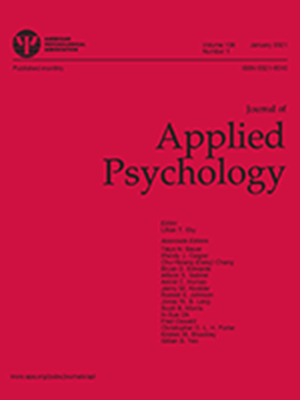Can allostatic load cross over? Short-term work and nonwork stressor pile-up on parent and adolescent diurnal cortisol, physical symptoms, and sleep.
IF 6.1
1区 心理学
Q1 MANAGEMENT
引用次数: 0
Abstract
Grounded in and expanding upon the allostatic load model, the present study examined how repeated exposure to work and nonwork stressors (i.e., stressor pile-up) across an 8-day study period relates to daily strain-related outcomes-diurnal cortisol, physical symptoms, and sleep quantity and quality-in both parents and their adolescent children. Nonlinear associations between daily stressor pile-up and daily strain were explored. Data from the Work, Family, and Health Network study (N = 131 parent-child dyads, n = 1,014 daily survey observations, n = 465 daily observations with cortisol) were used to test the study hypotheses. Parent work stressor pile-up and adolescent stressor pile-up were associated with increased daily physical symptom likelihood in parents and adolescents, respectively. Counter to expectations, parent nonwork stressor pile-up was associated with steeper daily cortisol slopes. Additionally, we found curvilinear crossover effects for sleep quantity, such that parent nonwork stressor pile-up and adolescent stressor pile-up were associated with shorter sleep duration among adolescents and parents (respectively), but this relationship plateaued and reversed as daily pile-up increased to more extreme levels. Our article explores conceptual and operational pile-up definitions (level of analysis, length of time window, inclusion of the current-day stressor events). Individual-level analyses supported more consistent, positive linear relationships between stressor pile-up and strains. Time window had little consequences for conclusions, but inclusion of the current day yields some alternative conclusions. We discuss implications for understanding stressor pile-up across domains and across parent-child dyads as it relates to daily strain within the family system. (PsycInfo Database Record (c) 2025 APA, all rights reserved).适应负荷可以跨越吗?短期工作和非工作压力源堆积在父母和青少年每天的皮质醇,身体症状和睡眠。
本研究基于并扩展了适应负荷模型,在为期8天的研究期间,研究了反复暴露于工作和非工作压力源(即压力源堆积)与父母及其青少年子女的日常压力相关结果(每日皮质醇、身体症状、睡眠数量和质量)之间的关系。探讨了日应力源堆积与日应变之间的非线性关系。来自工作、家庭和健康网络研究的数据(N = 131对亲子,N = 1,014次每日调查观察,N = 465次皮质醇每日观察)被用来检验研究假设。父母的工作压力源堆积和青少年的压力源堆积分别与父母和青少年的日常身体症状可能性增加有关。与预期相反,父母的非工作压力源堆积与每日皮质醇斜率更陡有关。此外,我们还发现了睡眠量的曲线交叉效应,例如父母的非工作压力源堆积和青少年的压力源堆积分别与青少年和父母的睡眠时间缩短有关,但随着每日堆积增加到更极端的水平,这种关系趋于稳定并逆转。我们的文章探讨了概念性和操作性的堆积定义(分析水平、时间窗口长度、当前压力源事件的包含)。个体水平的分析支持了压力源堆积和应变之间更一致的正线性关系。时间窗口对结论影响不大,但将当前日期纳入其中会产生一些不同的结论。我们讨论了理解压力源堆积跨领域和跨亲子双,因为它涉及到家庭系统内的日常压力的影响。(PsycInfo Database Record (c) 2025 APA,版权所有)。
本文章由计算机程序翻译,如有差异,请以英文原文为准。
求助全文
约1分钟内获得全文
求助全文
来源期刊

Journal of Applied Psychology
Multiple-
CiteScore
17.60
自引率
6.10%
发文量
175
期刊介绍:
The Journal of Applied Psychology® focuses on publishing original investigations that contribute new knowledge and understanding to fields of applied psychology (excluding clinical and applied experimental or human factors, which are better suited for other APA journals). The journal primarily considers empirical and theoretical investigations that enhance understanding of cognitive, motivational, affective, and behavioral psychological phenomena in work and organizational settings. These phenomena can occur at individual, group, organizational, or cultural levels, and in various work settings such as business, education, training, health, service, government, or military institutions. The journal welcomes submissions from both public and private sector organizations, for-profit or nonprofit. It publishes several types of articles, including:
1.Rigorously conducted empirical investigations that expand conceptual understanding (original investigations or meta-analyses).
2.Theory development articles and integrative conceptual reviews that synthesize literature and generate new theories on psychological phenomena to stimulate novel research.
3.Rigorously conducted qualitative research on phenomena that are challenging to capture with quantitative methods or require inductive theory building.
 求助内容:
求助内容: 应助结果提醒方式:
应助结果提醒方式:


